I did a double take at the temple’s empty guestbook as it was handed to me from the small, wooden ticket booth. Nope, no visitors yesterday. And just two the day before that: one German, one Thai.
What a difference a two-hour drive can make. I had spent the previous day at one of the world’s greatest tourist sites, the largest religious temple in the world, Angkor Wat. There, I’d had to use my guide’s local intel to get the best views before the crowds descended. And yet here we were on day two, just 160km up the road, with another temple all to ourselves.
I had taken a detour to the 12th-century Banteay Chhmar, which was also built during the reign of the almighty Khmer king Jayavarman VII. It is believed to have been a tribute to the Buddhist ruler’s son, who died in battle, but historians can’t be sure. It remains one of the most mysterious of all the Angkorian temples.
Tourism in Cambodia is focused on a few hotspots – those grand Angkor temples. When the country reopened its borders in the 1990s, after years of civil conflict, it welcomed just 100,000 visitors a year; by 2016, that figure had ballooned to five million, and it is forecast to rise again this year. Although barely 2,000 of those visit Banteay Chhmar, numbers were boosted slightly by the paving of the main road from Sisophon and Siem Reap in 2015.
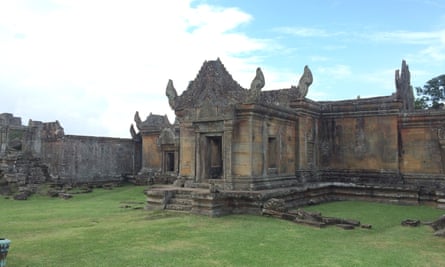
Banteay Chhmar temple was neglected for years: it was looted to near-devastation, its towers had almost entirely collapsed, and it was strewn with landmines during the civil war in the 1970s and 80s. But eventually the mines were cleared, and a team of archaeologists reconstructed what they could from the wreckage, and reopened the site in 2014.
Today, trees sprout on top of gallery walls, lichen dapples beheaded sculptures, and creepers hang between one tumbledown gateway to the next. One of the towers has been painstakingly rebuilt, and from its top, a giant stone face looks down with a gentle, almost paternal, smile.
I booked into one of the homestays (£5.50 a night) offered by Banteay Chhmar Community-Based Tourism (CBT). Come nightfall, the CBT arranged dinner in the temple grounds, surrounded by flaming torches, their resin made from local gum trees. To a throbbing chorus of cicadas, we ate soup made from channa striata, commonly known as snake fish. The CBT’s torch-lit dinner is available as part of a two-day package for $98 per person …
However, a private dinner at Angkor can cost tens of thousands of dollars, my guide, Bunt, told me. “I heard of one family from Germany who spent $125,000 on a meal. And they still woke up hungry the next day!”

My homestay, just across the road from the temple, was a stilted wooden house, with hammocks in its underbelly and an open stove in the corner. Upstairs, along a wide-open mezzanine lined with heavy wood furniture, I found a simple but comfortable bedroom, draped in mosquito nets and with a rumbling electric fan in the corner.
My hosts, Som and Saveoun, live there with their two-year-old, and have two children at university in the capital, Phnom Penh.
The next morning, after a giant plate of breakfast noodles, Bunt and I set off for another little-visited temple, Preah Vihear, the highest of the Khmer empire, crowning the Dangrek mountains.
It was more than three hours’ drive away, but for years it has been largely out of bounds because of a border dispute with Thailand. That dispute came to a head in 2011, when troops from the two countries clashed and dozens of soldiers were killed.
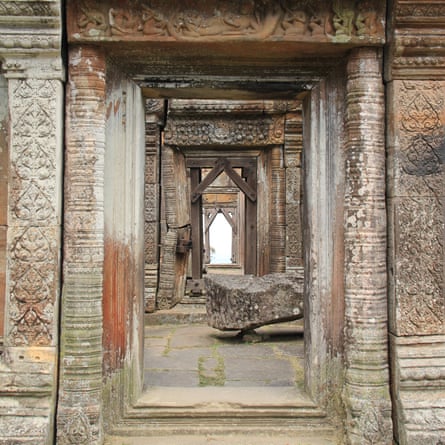
In 2013, the International Court of Justice ruled in Cambodia’s favour, the Thai army withdrew, and two years later the UK Foreign and Commonwealth Office deemed it safe to visit. There are still troops on the ground, but a peace deal has been struck and the area is slowly trying to build up its tourist industry. There is even a fancy hotel nearby, the Preah Vihear Boutique, with an inviting pool and a spectacular mahogany staircase (doubles from £65 a night B&B).
The temple itself is in an incredible setting. I craned my neck as we drove to the foot of the mountains, which jut out suddenly from the plains, with the shrine’s silhouette perched imposingly on the top.
Until three years ago, there was no road here; you’d have to trek through the undergrowth. Now, you can hitch a ride in an open-top truck or on a motorbike, and complete the steep climb in 15 minutes.
Whereas Banteay Chhmar was encased in jungle, like a secret hideaway, Preah Vihear stands stoically exposed, offering sweeping panoramic views. It also has different origins: it dates from the early 9th century, when it was dedicated to the Hindu god Shiva. Centuries later it became a hideout for the Khmer Rouge, the brutal regime that claimed the lives of up to two million Cambodians.

As incense wafted through the air, it was hard to believe the turbulent history of this serene temple. We passed through the dramatic winged gopura (entrance pavilion) to explore the causeways and carved galleries. Many were in decent condition, though some of the statues had been beheaded (looters again) and there were bullet holes in the sandstone.
If walls could talk, I don’t know where these timeworn witnesses would start. I am not even sure how Bunt managed to condense so much into his immersive crash-course. Cambodia is one of those places where you certainly leave with more than a suntan. And what I appreciated most about visiting its more secluded temples is the extra space and solitude that helps you begin to take it all in.
Way to go
The trip was provided by InsideAsia Tours, which has a six-night Rural Khmer Temples tour, which includes Preah Vihear and Siem Reap, from £1,549pp, including private guide and transport, but excluding flights
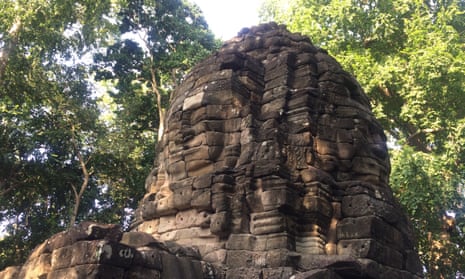



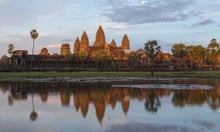
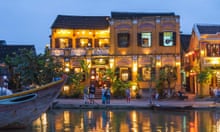

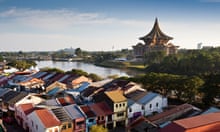

Comments (…)
Sign in or create your Guardian account to join the discussion